 After being bowled over by Ricoh’s GR Digital camera (so good we went out and bought the thing), we were keen to review their new consumer-based point’n’shooter, the Caplio R4.
After being bowled over by Ricoh’s GR Digital camera (so good we went out and bought the thing), we were keen to review their new consumer-based point’n’shooter, the Caplio R4.
Despite boasting an impressive set of specs – a class-leading 7.1x optical wide zoom, (28-200 mm, 35 mm equiv), image stabilisation, 6 megapixel CCD and big LCD monitor – the Ricoh is a bijou little fella, measuring a pocketable 95 x 53 x 26 mm.
Getting to grips with the R4
Finished in an attractive black finish with a silver band and lens surround, the controls of the R4 are well laid out, with a gently contoured grip on the right hand side making it easier to keep a hold of the diminutive snapper.
 A large and bright 2.5″ LCD 253k pixels screen dominates the rear of the camera, with a familiar four way controller/OK button supplemented by a zoom rocker switch.
A large and bright 2.5″ LCD 253k pixels screen dominates the rear of the camera, with a familiar four way controller/OK button supplemented by a zoom rocker switch.
A row of five buttons next to the LCD screen let users select voice/movie or still mode, playback, adjust, delete/self-timer and display options.
On the top plate there’s just the power switch, the large shutter release and a recessed button to turn the image stabilisation on/off.
 That mighty lens
That mighty lens
There’s no other way of saying it: when it comes to lenses, the Ricoh has got a whopper.
Starting at a pleasingly wide 28mm (perfect for landscapes) the zoom goes all the way up to a privacy-invading 200mm with the Double Retracting Lens System miraculously extending an elephantine protuberance out of the 26mm thin body.
Although it’s not the fastest lens in town (F3.3-4.8), the images were pretty sharp, although the whirring and grinding of the zoom and focus mechanism might not make this a suitable camera for snapping candids in a church.
The macro performance was particularly impressive, focussing down to an astonishing 1cm – we particularly liked being able to manually select the focus area by moving a cursor across the screen with the four way controller.
 Exposure options
Exposure options
The Caplio offers a selection of auto scene modes including portrait, sports, landscape, night scene and text.
Although we’re not fans of cameras offering mile-long lists of presets covering every conceivable exposure option known to man, we fancy that Ricoh could have included a few more for new users.
In line with its point’n’shoot aspirations, there’s no manual controls to be found, although the ‘adjust’ button lets users quickly tweak white balance, exposure compensation and ISO ratings.
 Twisting trapezoids
Twisting trapezoids
A curious ‘skew correction mode’ feature selectable through the scene mode menu automatically detects trapezoids in images and corrects the perspective so the object appears as if they were shot ‘head on’.
Although you could easily do this in Photoshop, it’s a fun feature and handy when you’re photographing things like whiteboards, documents and magazines.
There’s also the option to display an onscreen histogram, but we reckon that’s more likely to hinder than help the average snapper as they’re not the easiest of things to understand.
Using the camera
Generally, we were impressed with the performance of the Ricoh, which was responsive to the touch and fast in operation throughout our tests.
The camera’s interface was easy to understand and we rarely found ourselves getting lost in sub-menus.
 Quick to start up (just over a second), the Ricoh proved to be a speedy performer with fast focusing and a near instantaneous shutter response guaranteeing that we got the shot.
Quick to start up (just over a second), the Ricoh proved to be a speedy performer with fast focusing and a near instantaneous shutter response guaranteeing that we got the shot.
Trying to take a fast sequence of shots in normal shooting mode made us a little too familiar with the ‘writing to card’ warning which appeared after just two photos, but in ‘continuous shooting’ mode the Ricoh rattled off five shots in rapid succession (we’re not convinced that the ability to fire off shots paparazzi-style is that important to the target audience anyway).
Like its big brother, the Ricoh GR, the G4 includes manual focus options – a welcome addition at this price range.
This lets users manually set the focus distance or use the preset ‘snap’ or ‘infinity’ options (great for parties and landscapes respectively).
Shaking all over
At the 200mm end of the zoom range, some kind of image stablisation is essential in all but the sunniest of climes, and it’s good to see Ricoh’s engineers squeezing in this feature into such a compact camera.
The R4’s vibration correction system – which moves the CCD in the opposite direction to counterbalance camera shake – proved to be pretty effective in use, although the recessed on/off control was needlessly awkward to activate.
 Considering the price range and feature set, we were also pleased with the picture quality – exposures were generally spot on and focusing was consistently good throughout.
Considering the price range and feature set, we were also pleased with the picture quality – exposures were generally spot on and focusing was consistently good throughout.
Good for noise, bad for banding
Examining photos onscreen, we did notice some visible banding across just one or two images – usually in high contrast scenes. This rather blotted Ricoh’s copybook, with one photo taken of the Telecom Tower in London against a cloudy white sky bordering on unusable.
Noise levels were well under control at 64 -100 ISO, and still fairly reasonable up to 400 ISO.
 By 800 ISO we were entering arctic snowstorm territory, but the results were still easily usable for 6″ x 4″ prints (after a bit of cleaning up with noise-reduction programs like Noise Ninja).
By 800 ISO we were entering arctic snowstorm territory, but the results were still easily usable for 6″ x 4″ prints (after a bit of cleaning up with noise-reduction programs like Noise Ninja).
We didn’t see much in the way of pesky purple fringing (certainly far less than the Fuji F10/F11) and we were pleased with the lens performance overall.
Despite the big LCD screen and onboard image stabilisation, battery life was more than ample, and we were still powering on after taking over 250 photos.
Conclusion
The mid-range digital compact market is already saturated with some heavyweight contenders, but we feel the Ricoh’s compelling feature set, image stabilisation and enormous lens makes it a camera worthy of anyone’s shortlist.
Although we did have one or two problems with banding, we were won over by the R4’s speedy operation, easy-to-understand controls and comfortable handling.
Most of all, we loved having a proper wideangle zoom, with the 28mm setting adding real versatility to the camera – now you won’t have to herd your friends together into impossibly tight spaces when taking group shots.
Add to that the impressive 200mm telephoto range and the user-friendly controls all wrapped up in a pocket sized package and we think that Ricoh’s got a winner on its hands with the R4
The Caplio R4 should be on the shelves now for around £250 ($443, €361).
Rating
Ease of use: 85%
Picture quality:78%
Features: 80%
Value for money: 85%
Overall: 84%
Caplio R4 specifications
Sensor 1/2.5 ” Type CCD, 6.04 million effective pixels
Image sizes 2816 x 2112, o 2784 x 1856, 2048 x 1536, 1280 x 960, 640 x 480
Movie clips 320 x 240, 160 x 120
Sound WAV
File formats JPEG (Exif 2.2), AVI Motion JPEG
Lens 28-200mm equiv, F3.3-4.8, 7.1x optical zoom
Image stabilization CCD shift method
Digital zoom up to 3.6x
Focus Auto focus, Manual Focus, Snap
AF assist lamp Yes
Focus distance Normal: 0.3-1.0m, Macro: 0.01-0.14m
Metering 256 multi segment, Center weighted, Spot
ISO sensitivity Auto, ISO 64, ISO 100, ISO 200, ISO 400, ISO 800
Exposure compensation +/-2EV, 1/3 EV steps
Exposure bracketing -0.5EV, ±0, +0.5EV
Shuttter speed 8, 4, 2, 1-1/2000 secs
Aperture F3.3-4.8
Modes Still (Continuous, S-Continuous, M-Continuous)
Scene modes Portrait, Sports, Distant landscape, Night scene, Text, High sensitivity, Zoom macro, Skew correction
White balance Auto, Daylight, Overcast, Tungsten light 1 / 2, Fluorescent, Manual
Self timer 2 or 10 secs
Continuous shooting Continuous, S-Continuous, M-Continuous
Flash Auto, Red-eye reduction, Flash on / off, Slow synch
Range: 0.2-0.4m (wide) 0.14-1.8m (tele)
Viewfinder No
LCD monitor 2.5-inch TFT, 114,000 pixels
Connectivity USB 1.1, AV out
Storage 26MB internal memory, SD / MMC compatible
Weight (no batt) 135 g
Dimensions 95 x 53 x 26 mm
Ricoh
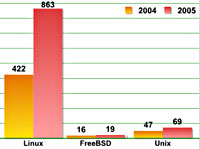 Attacks against non-Windows operating systems – particularly Linux – are growing quickly, according to a Kaspersky Lab report.
Attacks against non-Windows operating systems – particularly Linux – are growing quickly, according to a Kaspersky Lab report. Those Mac bugs
Those Mac bugs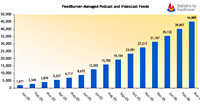 Feedburner are claiming that there are now more podcasts than radio stations in the world.
Feedburner are claiming that there are now more podcasts than radio stations in the world. A clearly excited Klau switched to hyperbolic: “Back in 2000, the DVD format, just 3 years old at the time, was declared the most successful product launch in consumer electronics history, outselling the VCR five to one.”
A clearly excited Klau switched to hyperbolic: “Back in 2000, the DVD format, just 3 years old at the time, was declared the most successful product launch in consumer electronics history, outselling the VCR five to one.”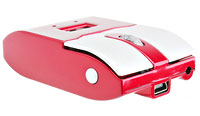 We must have all suffered this nightmare scenario.
We must have all suffered this nightmare scenario.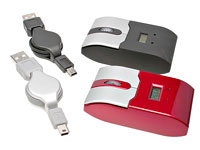 Well, worry no more, because thanks to those clever folks at Brando, you can now own a USB mouse that packs both a thermometer and a laser pointer.
Well, worry no more, because thanks to those clever folks at Brando, you can now own a USB mouse that packs both a thermometer and a laser pointer.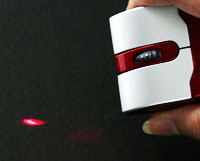 Whip that puppy out at a corporate meeting and you’ll be the cock o’the walk!
Whip that puppy out at a corporate meeting and you’ll be the cock o’the walk! Their Website gives no indication as to the power of the pointer, but the illustration seems to suggest it can blast its mighty beam all of, err, a couple of feet, at best.
Their Website gives no indication as to the power of the pointer, but the illustration seems to suggest it can blast its mighty beam all of, err, a couple of feet, at best.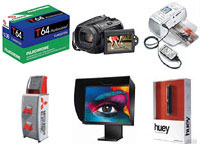 Nikon has scooped up three prizes at the 2006 TIPA (Technical Image Press Association) awards, with Canon, Panasonic, Samsung, Ricoh, Epson, Lexar and Olympus all getting the opportunity to make tearful speeches on the podium.
Nikon has scooped up three prizes at the 2006 TIPA (Technical Image Press Association) awards, with Canon, Panasonic, Samsung, Ricoh, Epson, Lexar and Olympus all getting the opportunity to make tearful speeches on the podium.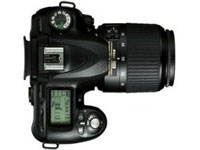 The D50 is a great stepping stone for amateurs looking to snap high quality pics without spending a fortune.
The D50 is a great stepping stone for amateurs looking to snap high quality pics without spending a fortune.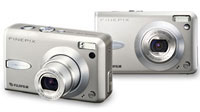 With that kind of resolution, images can be blown up to enormo-size without fear of pesky artifacts appearing, and the full frame sensor means that the focal lengths of Canon EF lenses remain consistent.
With that kind of resolution, images can be blown up to enormo-size without fear of pesky artifacts appearing, and the full frame sensor means that the focal lengths of Canon EF lenses remain consistent.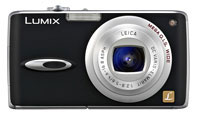 The world\\’s first digital compact camera to deliver ISO 3200 sensitivity at full resolution, the F30 can serve up sharp images in low light and comes with a slew of scene modes to get you started.
The world\\’s first digital compact camera to deliver ISO 3200 sensitivity at full resolution, the F30 can serve up sharp images in low light and comes with a slew of scene modes to get you started. Other category winners:
Other category winners: Ever growing hordes of people are using their phones to access the Web according to a study by market research firm Ipsos Insight.
Ever growing hordes of people are using their phones to access the Web according to a study by market research firm Ipsos Insight. The UK came in at second place, with 29 per cent of Brits using their mobile dog’n’bone in the rub-a-dub, sherbet dab and Colonel Gadaffi to get on the, err, Sportsman’s Bet*.
The UK came in at second place, with 29 per cent of Brits using their mobile dog’n’bone in the rub-a-dub, sherbet dab and Colonel Gadaffi to get on the, err, Sportsman’s Bet*. With the recent introduction of more generous data tariffs in the UK (like T-Mobiles unlimited Web’n’Walk deal), mobile surfing usage is tipped to soar, with operators looking to bolt on revenue-attracting mobile services, like search or map functions.
With the recent introduction of more generous data tariffs in the UK (like T-Mobiles unlimited Web’n’Walk deal), mobile surfing usage is tipped to soar, with operators looking to bolt on revenue-attracting mobile services, like search or map functions. In the world of online commerce, uptime is money, so it was surprising to see a new report by WatchMouse showing that 57% of the FTSE 100 websites were offering availability below industry standards
In the world of online commerce, uptime is money, so it was surprising to see a new report by WatchMouse showing that 57% of the FTSE 100 websites were offering availability below industry standards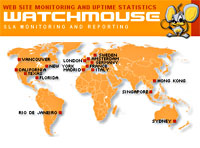 With an uptime of 99.9% seen as the industry standard (minimum acceptable level), there were fourteen sites which achieved perfect 100% availability, while the worst two performers couldn’t even muster 91% availability (Scottish Power with 90.78% and United Utilities with a lamentable 81.53%).
With an uptime of 99.9% seen as the industry standard (minimum acceptable level), there were fourteen sites which achieved perfect 100% availability, while the worst two performers couldn’t even muster 91% availability (Scottish Power with 90.78% and United Utilities with a lamentable 81.53%).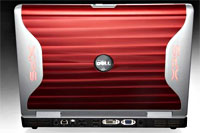 Dell has released a beast of a notebook, with its dual-core processor, groovy glowing lights and ramped-up video RAM aiming the XPS M1710 squarely at mobile gamers.
Dell has released a beast of a notebook, with its dual-core processor, groovy glowing lights and ramped-up video RAM aiming the XPS M1710 squarely at mobile gamers.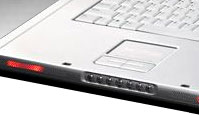 The Metallic Black M1710 weighs in at a wallet-draining $2,600 and comes with Intel’s Core Duo T2400 processor, 1GB of DDR2 memory, 256MB GeForce Go 7900 GS graphics and a 60GB hard drive.
The Metallic Black M1710 weighs in at a wallet-draining $2,600 and comes with Intel’s Core Duo T2400 processor, 1GB of DDR2 memory, 256MB GeForce Go 7900 GS graphics and a 60GB hard drive.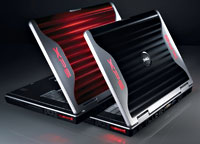 Both notebooks feature Microsoft’s Windows Media Center Edition operating system, and system upgrades can expand storage to 120 of GB hard drive space and up to 4 GB of 667MHz DDR2 memory.
Both notebooks feature Microsoft’s Windows Media Center Edition operating system, and system upgrades can expand storage to 120 of GB hard drive space and up to 4 GB of 667MHz DDR2 memory. There’s also built in Wi-Fi, high definition integrated stereo with two 2 watt per channel main speakers and a 5 watt, class D subwoofer with bass reflex port.
There’s also built in Wi-Fi, high definition integrated stereo with two 2 watt per channel main speakers and a 5 watt, class D subwoofer with bass reflex port.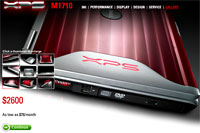 The XPS M1710 is estimated to ship in the second week of May. EK/EU delivery and prices to be announced.
The XPS M1710 is estimated to ship in the second week of May. EK/EU delivery and prices to be announced.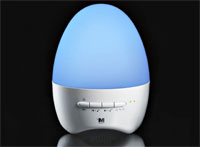 If there’s one thing we’ve always thought that’s been missing when we’ve been grooving to our MP3 files, it’s an egg-shaped device that changes colour to the music.
If there’s one thing we’ve always thought that’s been missing when we’ve been grooving to our MP3 files, it’s an egg-shaped device that changes colour to the music. If you’re rocking out at home, the lights go up to 11 for Hip Pop or dance music, while if you’re in the mood to get down with your laydee, the LEDs will glow all soft and romantic as you slip on some sweet-talking tunes from the love lothario himself, Chris ‘look out ladies’ DeBurgh.
If you’re rocking out at home, the lights go up to 11 for Hip Pop or dance music, while if you’re in the mood to get down with your laydee, the LEDs will glow all soft and romantic as you slip on some sweet-talking tunes from the love lothario himself, Chris ‘look out ladies’ DeBurgh.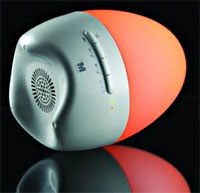 The player supports MP3 and WMA format music files and also comes with a line-in connector for non-USB audio devices, such as CD players and cassette recorders.
The player supports MP3 and WMA format music files and also comes with a line-in connector for non-USB audio devices, such as CD players and cassette recorders.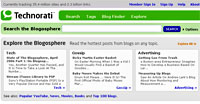 In February, we reported how
In February, we reported how 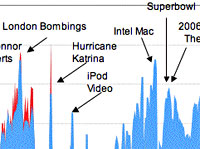 Blogging has now become such a significant part of some
Blogging has now become such a significant part of some  Pesky blog spammers have been generating an increasing level of noise with their nefarious activities throughout 2006, but the level of genuine, original content still greatly outweighs the fake and/or regurgitated content churned out on splogs.
Pesky blog spammers have been generating an increasing level of noise with their nefarious activities throughout 2006, but the level of genuine, original content still greatly outweighs the fake and/or regurgitated content churned out on splogs.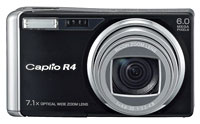 After being bowled over by Ricoh’s GR Digital camera (so good we went out and bought the thing), we were keen to review their new consumer-based point’n’shooter, the Caplio R4.
After being bowled over by Ricoh’s GR Digital camera (so good we went out and bought the thing), we were keen to review their new consumer-based point’n’shooter, the Caplio R4. A large and bright 2.5″ LCD 253k pixels screen dominates the rear of the camera, with a familiar four way controller/OK button supplemented by a zoom rocker switch.
A large and bright 2.5″ LCD 253k pixels screen dominates the rear of the camera, with a familiar four way controller/OK button supplemented by a zoom rocker switch.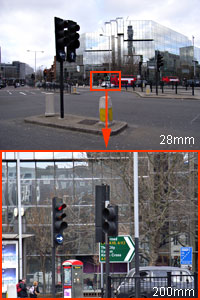 That mighty lens
That mighty lens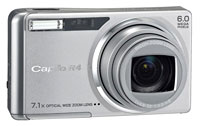 Exposure options
Exposure options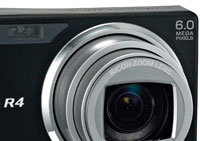 Twisting trapezoids
Twisting trapezoids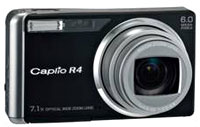 Quick to start up (just over a second), the Ricoh proved to be a speedy performer with fast focusing and a near instantaneous shutter response guaranteeing that we got the shot.
Quick to start up (just over a second), the Ricoh proved to be a speedy performer with fast focusing and a near instantaneous shutter response guaranteeing that we got the shot. Considering the price range and feature set, we were also pleased with the picture quality – exposures were generally spot on and focusing was consistently good throughout.
Considering the price range and feature set, we were also pleased with the picture quality – exposures were generally spot on and focusing was consistently good throughout.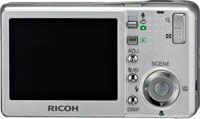 By 800 ISO we were entering arctic snowstorm territory, but the results were still easily usable for 6″ x 4″ prints (after a bit of cleaning up with noise-reduction programs like Noise Ninja).
By 800 ISO we were entering arctic snowstorm territory, but the results were still easily usable for 6″ x 4″ prints (after a bit of cleaning up with noise-reduction programs like Noise Ninja).